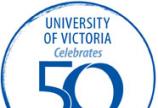James Pearce, master maintenance man
- Rowan Grant

With a passion for how things work and an eye for efficiency, James Pearce helped bring the University of Victoria’s grounds into the twenty-first century.
Different kinds of people experience UVic from different vantage points. Academics know it as a hotbed for research and knowledge. For activists, it introduces a world of issues and opportunities. The socially inclined are able to appreciate the broad diversity of its population. But no one understands the University of Victoria quite like James Pearce.
As the Department of Facilities Management’s manager of maintenance and operations from 1985 to 2005, Pearce oversaw the campus’ plumbers, electricians, mechanics, painters, locksmiths and maintenance crew. From the backrooms and corridors of the campus’ unassigned space—the parts of the buildings Pearce and his staff know best—he monitored utility systems, assessed facilities’ viability, and solved mechanical issues. In other words, Pearce was in charge of making UVic’s campus efficient. With a passion for how things work and an exclusive understanding of the campus’ technical side, Pearce changed UVic in ways few could imagine.
Pearce graduated from McGill in 1966 with a degree in mechanical engineering. He then worked for Honeywell Ltd., designing control systems for plants in Quebec and Ontario. But his time at UVic taught Pearce to use another kind of skill: “This is a place where people are thinking all the time,” he says, describing what it was like working at UVic for 20 years. “You sort of start to adopt that yourself.” Indeed, while Pearce’s title may suggest he worked mostly with his hands, his legacy at UVic rests in his way of thinking.
As maintenance manager for all of the ’90s, a period during which environmental issues came to the forefront of facilities management, Pearce played a large role in bringing UVic into the twenty-first century in terms of sustainability. Perhaps his most significant achievement involved saving the university large amounts of energy and money in lighting systems.
While T8 lights had become mandatory in new buildings, Pearce noticed the way the university could save money lay in the campus’ older buildings, which still used an older kind of fluorescent lighting. In a presentation to the university’s administration, he made the point that T8 lights used 26 per cent less energy than the older fluorescent lights did. Over time, he argued, replacing the older fluorescent lights would prove cost saving. As administration gradually began installing T8 lights in the older buildings, it saw that Pearce was right. By the time of his retirement, UVic had saved approximately $10 million by updating the older buildings’ lighting systems. Most contributions of his size come on the grounds of philanthropy; Pearce’s came from good thinking.
Pearce also revolutionized the way UVic managed its power consumption. Before his arrival, only the campus’ major buildings had analog meters to measure consumption. When these needed recalibrating in the early ’90s, Pearce thought progressively, turning to a new technology developed by Power Measurement Ltd., a local manufacturer. “[These] were the first digital-type meters,” says Pearce. “They measured not only the consumption but a whole set of electrical variables that could determine the quality of your power as well.” Power Measurement used UVic as a beta site for its products, and the experiment proved successful. Today, the university owes its ability to measure and assess the quality of its energy to the system implemented by Pearce. This system remains essential to its ability to practice sustainable energy consumption.
Overseeing these kinds of projects taught Pearce how to appreciate the way things change. None of the projects he implemented occurred overnight. He says he came to respect the process of researching projects, proving their viability, and gradually earning the trust and funding from administration.
“You don’t get to do things in big steps,” says Pearce. “Nobody showers a whole lot of money on your department to do something like that. You’re much better off to have a grand plan. It may take ten or twenty years. But the first step should always lead to the last step of your plan.” Pearce considers accepting this a key ingredient to the success he achieved during his 20-year tenure at UVic.
Pearce’s reputation, however, rests on more than just the projects he oversaw. His philosophy for the Department of Facilities Management stressed that all staff practiced good PR and people skills, attributes most facility managers tend to overlook. In interviews, he would look beyond the technical skills of a plumber or an electrician to ensure he or she upheld the kind of friendliness he considered vital to the department’s success.
“Tradespeople are, for the most part, equally qualified,” Pearce explains. “What you have to be able to do is get along with the people you’re doing services for.”
Under Pearce’s management, maintenance staff at UVic became easy to work alongside. Staff members of other departments will remember this as a unique feature of Pearce’s management style. When asked about his favourite part of his job, Pearce does not bring up his love for engineering or the grounds himself. Without hesitating, he answers, “The people.”
In his 21 years at UVic, Pearce saw the university from a vantage point no one else could: from behind the scenes. He still carries a fondness for the places only he and his staff were able to visit. Among his favourite are the buildings’ roofs. “I’ve been on all the roofs. No one is allowed on the roofs except for the facilities management,” says Pearce. “It’s a very nice view.”


